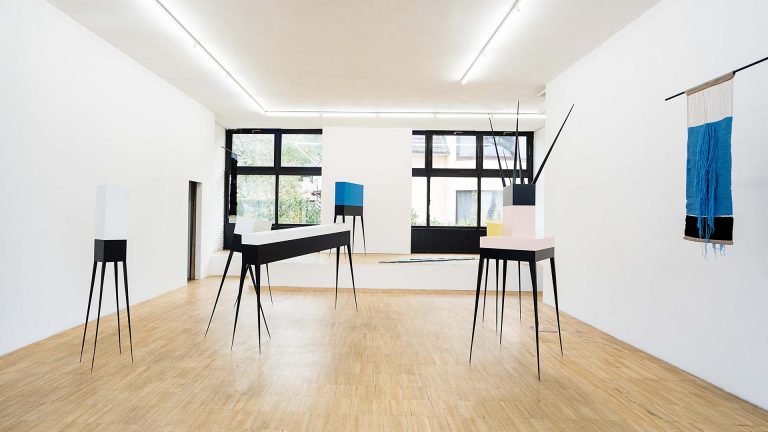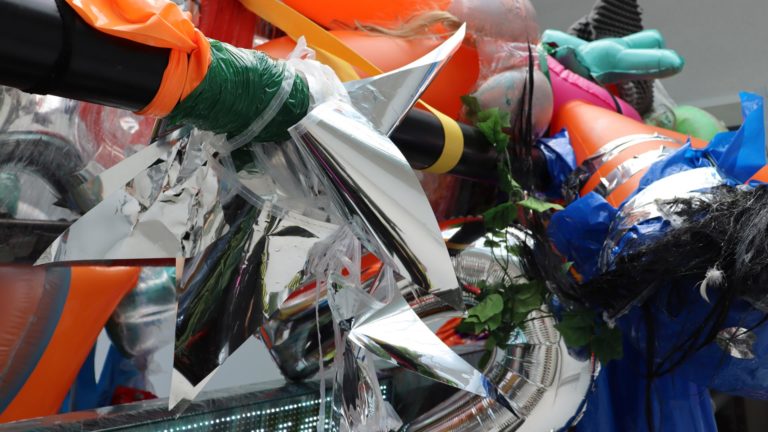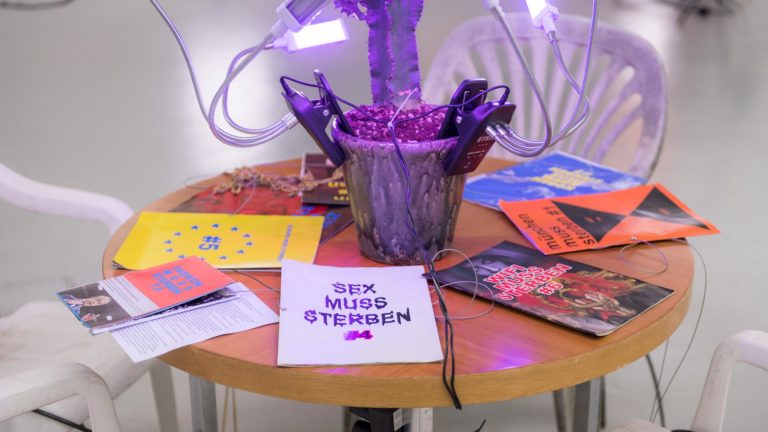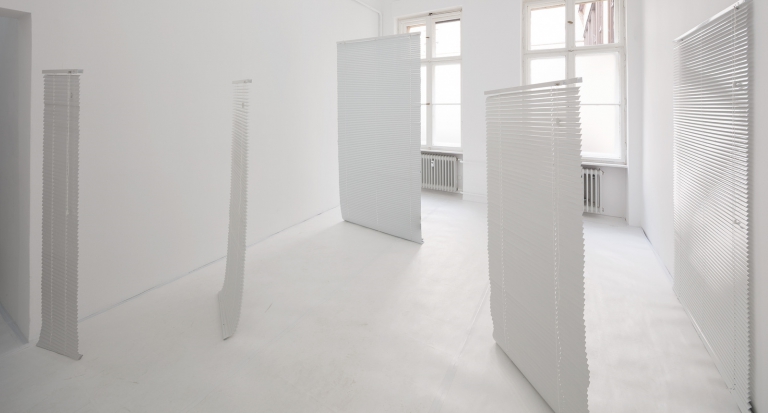Exhibition title: Aurora Boraelis
Venue: Galerie Neu, Berlin, Germany
Date: January 19 – March 1, 2017
Photography: all images copyright and courtesy of the artist and Galerie Neu, Berlin
For the longest time, we talked about the relation between images and their supports: the material on which an image was produced, the way in which this material conditioned the image itself and the efforts, throughout the history of art, to either emphasize or hide the impact of the support. Watercolor paintings expose the graininess of the paper base, the way in which it absorbs or distributes liquids. Slick layers of oil pigments and glaze in 17th century painting helped viewers forget the canvas underneath, as well as the materiality of paint itself; 20th century painters had no qualms about exposing both. In contrast, a tapestry erases all distinctions between image and support, since the interaction of warp and woof – the woven pattern – is the image itself.
In fact, it was the structural similarity between weaving and electronics – first pointed out by early video and computer artists who had to contend with the fact that their images were simply the ephemeral effects of signals and code – that displaced the discourse of image supports. In the age of electronic networks, the relation between image and infrastructure became paramount: ephemeral imagery in nature (from the aurora borealis to dreams and hallucinations) gave added weight to this idea. Institutional, ideological and psychological infrastructures were now seen in light of the new technological affordances of the information age. The work of Sean Snyder situates itself at that juncture where the question of support explicitly confronts the vertiginous and at times paranoid question of information infrastructures, exposing less what an image is or what it represents than the new type of organizational forces that run through it.
Such infrastructural concerns were at once exposed and parodied in Snyder’s contribution to Grey Room journal’s recent dossier on the occasion of the election of Donald Trump as the next president of the U.S.A. The item in question is a Dec. 24 letter to the Department of Homeland Security, in which Snyder reports on suspicious activity in compliance with the preemptive logic of the 2001 Patriot Act. Yet Snyder frames his findings by first evoking an ephemeral image, more specifically the famous dream image in which Sigmund Freud appears as an elephant, because, as Freud’s patient explained to him: Vous me trompez (you are deceiving me). The image is nothing in itself; it is simply a function of the metonymic, or loosely associative, production of the elephant trunk (= trompe in French). The spirit of paranoia thus established – no one mentioned, no one forgotten, least of all the Republican Party and the name of its 2016 presidential nominee – the letter goes on to produce a web or weave of other associations – mainly between a red, white and blue Slurpee slush drink that was deliberately knocked out of the hands of its holder and splattered on the street in Washington DC between a 7-11 and the International Spy Museum, and the exhibition of the Cold War-era CIA-supported Jackson Pollock Lavender Mist painting on the walls of the nearby Smithsonian National Gallery of Art.
Fruitless enquiries about such connections having been addressed to the Smithsonian Air and Space Museum as well as the White House, Snyder thought it safest to alert the DHS. In the age of critical infrastructures, this is, apparently, the sort of organization best equipped to handle the new type of “trompe l’oeil effects” at work in contemporary imagery, the new “art of deception”.
Sean Snyder, Silence (Audition), 2016-2017, 16:9 format HD video, 4 minutes 33 secondes, color, audio, flatscreen monitor (Sony KDL-49WD755 LED TV with Sony MDR 100ABN noise cancelling, bluetooth, wireless headphones)
Sean Snyder, Magnetosphere (collaboration with Bernhard Schreiner), 2016-2017, infinite loop played on Sony-NWZB1183B Walkman with Sony MDR-100AAP
Sean Snyder, Tableau Bateau, 2016, Random loop on hacked Sony XPERIA Z Ultra; PVC structure RAL 9003 (Signal, white, Blanc de sécurité, Signalweiß), PVC structure: 120 x 40 x 30 cm (4:3)
Sean Snyder, Network (Les Animaux De La Ferme), 2016, bon wood, archival pigment prints on matte paper, aluminium frame, 101 x 163 x 1 cm
Sean Snyder, Duty-Free Molotov Cocktail, 2016-2017, Clear Acrylic Structure (101 cm x 101 cm x 120 cm high), Absolut Glimmer, Limited Edition Plain Vodka 175 cloth, Red White Check Pattern Scarf, 120 x 101 x 101 cm
Sean Snyder, Cloud Sediment (Gstaad), 2015 – 2016, 16:9 format HD video, 7 minutes 47 secondes, black/white and color, audio, on, wall painted RAL 7043 (Gris Signalisation, Trafic Grey, Verkehrsgrau), 180 cm x 320 cm projection (60 cm from floor)
Sean Snyder, Mnemonic Equation (Level 5), 2017, 25 bon wood archival pigment prints on matte paper, 30 x 48.5 cm, mounted on 3 mixed media aluminium, installed on wall painted RAL 7047, 240 x 332.5 cm


















